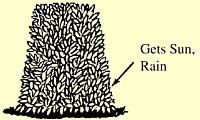Pruning Shrubs and Hedges

Leaving the bottom of the hedge wider than the top allows sunlight and rain to reach all of the plant.
How to properly prune your hedge depends on the type of hedge that you have. Informal hedges consist of a row of closely planted shrubs which are allowed to develop into their natural shape. Annual pruning involves thinning and shaping just enough to maintain desired height and width.
Formal hedges have a hard outline of foliage from the top of the hedge to the ground. They should be clipped while the new growth is green. The most common mistake people make when trimming a hedge is cutting the plant into a sharply-edged box shape. It's important to trim a hedge so that the top is narrower than the bottom; this way, sunlight can reach all the plant's leaves. The bottom branches of "box-shaped" hedges usually thin out—and even die—from lack of sunlight. Prune flowering hedges after they've bloomed in order to avoid cutting off buds.
Renovating Shrubs
If you've seen older shrubs that look like giant stems of broccoli, then you've seen shrubs that are ready for renovation. Shrubs that aren't properly pruned over the years can become tall and leggy, bushy and oversized, or just plain ugly.
But renovating them is simple. In early spring, cut them down to within a few inches of the soil. Over the next few years, the plants will typically regrow in their natural form with healthy, vigorous growth.
Renovation is a fairly aggressive practice and won't work with all shrubs, especially certain evergreens.
An alternative is to rejuvenate your shrubs by removing one-third of the plant each year for three years.

